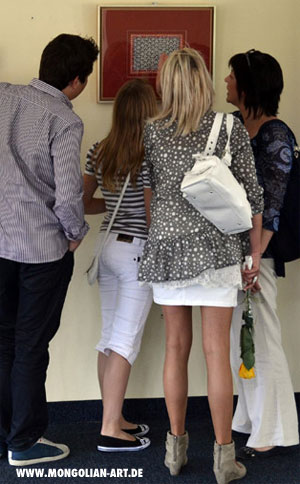

Exhibition "MONGOL AYAN 1" in France 2011
'ZURAG' film original in German 2010 Berlin
'ZURAG' film in the Mongolian national television, 2011 Ulan Bator
(Original record from the MNB broadcast)


| 1000
People -01,
Tempera on cotton, 17,5 x 24cm, Years 1999-2002 OTGO Although this miniature painting "1000 people" is only 17.5 x 24 cm high, are more than 1000 people depicted. It always compares it with Kamasutra. Kama Sutra The Kama Sutra, (alternative spellings: Kamasutraṃ or simply Kamasutra), is an ancient Indian text widely considered to be the standard work on human sexual behavior in Sanskrit literature written by the Indian scholar Mallanāga Vātsyāyana. A portion of the work consists of practical advice on sex It is largely in prose, with many inserted anustubh poetry verses. Kāma means sensual or sexual pleasure, and "sūtra" literally means a thread or line that holds things together, and more metaphorically refers to an aphorism (or line, rule, formula), or a collection of such aphorisms in the form of a manual.. The Kama Sutra is the oldest and most notable of a group of texts known generically as Kama Shastra (Sanskrit: Kāma Śhāstra).Traditionally, the first transmission of Kama Shastra or "Discipline of Kama" is attributed to Nandi the sacred bull, Shiva's doorkeeper, who was moved to sacred utterance by overhearing the lovemaking of the god and his wife Parvati and later recorded his utterances for the benefit of mankind. Historian John Keay says that the Kama Sutra is a compendium that was collected into its present form in the second century CE. Content The Mallanaga Vatsyayana's Kama Sutra has 1250 verses, distributed in 36 chapters, which are further organized into 7 parts. According to both the Burton and Doniger translations, the contents of the book are structured into 7 parts like the following:
Some Indian philosophies follow the "four main goals of life",known as the purusharthas: 1). Dharma: Virtuous living. 2). Artha: Material prosperity. 3). Kama: Aesthetic and erotic pleasure.4). Moksha: Liberation. Dharma, Artha and Kama are aims of everyday life, while Moksha is release from the cycle of death and rebirth. The Kama Sutra (Burton translation) says: "Dharma is better than Artha, and Artha is better than Kama. But Artha should always be first practised by the king for the livelihood of men is to be obtained from it only. Again, Kama being the occupation of public women, they should prefer it to the other two, and these are exceptions to the general rule." (Kama Sutra 1.2.14) Of the first three, virtue is the highest goal, a secure life the second and pleasure the least important. When motives conflict, the higher ideal is to be followed. Thus, in making money virtue must not be compromised, but earning a living should take precedence over pleasure, but there are exceptions. In childhood, Vātsyāyana says, a person should learn how to make a living; youth is the time for pleasure, and as years pass one should concentrate on living virtuously and hope to escape the cycle of rebirth. Also the Buddha preached a Kama Sutra, which is located in the Atthakavagga (sutra number 1). This Kama Sutra, however, is of a very different nature as it warns against the dangers that come with the search for pleasures of the senses. Many in the Western world wrongly consider the Kama Sutra to be a manual for tantric sex. While sexual practices do exist within the very wide tradition of Hindu Tantra, the Kama Sutra is not a Tantric text, and does not touch upon any of the sexual rites associated with some forms of Tantric practice. Translations The most widely known English translation of the Kama Sutra was privately printed in 1883. It is usually attributed to renowned orientalist and author Sir Richard Francis Burton, but the chief work was done by the pioneering Indian archaeologist, Bhagvanlal Indraji, under the guidance of Burton's friend, the Indian civil servant Foster Fitzgerald Arbuthnot, and with the assistance of a student, Shivaram Parshuram Bhide. Burton acted as publisher, while also furnishing the edition with footnotes whose tone ranges from the jocular to the scholarly. Burton says the following in its introduction: It may be interesting to some persons to learn how it came about that Vatsyayana was first brought to light and translated into the English language. It happened thus. While translating with the pundits the `Anunga Runga, or the stage of love', reference was frequently found to be made to one Vatsya. The sage Vatsya was of this opinion, or of that opinion. The sage Vatsya said this, and so on. Naturally questions were asked who the sage was, and the pundits replied that Vatsya was the author of the standard work on love in Sanskrit literature, that no Sanscrit library was complete without his work, and that it was most difficult now to obtain in its entire state. The copy of the manuscript obtained in Bombay was defective, and so the pundits wrote to Benares, Calcutta and Jaipur for copies of the manuscript from Sanskrit libraries in those places. Copies having been obtained, they were then compared with each other, and with the aid of a Commentary called `Jayamangla' a revised copy of the entire manuscript was prepared, and from this copy the English translation was made. The following is the certificate of the chief pundit: `The accompanying manuscript is corrected by me after comparing four different copies of the work. I had the assistance of a Commentary called "Jayamangla" for correcting the portion in the first five parts, but found great difficulty in correcting the remaining portion, because, with the exception of one copy thereof which was tolerably correct, all the other copies I had were far too incorrect. However, I took that portion as correct in which the majority of the copies agreed with each other.' In the introduction to her own translation, Wendy Doniger, professor of the history of religions at the University of Chicago, writes that Burton "managed to get a rough approximation of the text published in English in 1883, nasty bits and all". The philologist and Sanskritist Professor Chlodwig Werba, of the Institute of Indology at the University of Vienna, regards the 1883 translation as being second only in accuracy to the academic German-Latin text published by Richard Schmidt in 1897. The English translation by Wendy Doniger and Sudhir Kakar, the Indian psychoanalyst and senior fellow at Center for Study of World Religions at Harvard University is becoming regarded as the standard text; it was published by Oxford University Press in 2002. Doniger contributed the Sanskrit expertise while Kakar provided a psychoanalytic interpretation of the text. A noteworthy translation by Indra Sinha was published in 1980. In the early 1990s its chapter on sexual positions began circulating on the internet as an independent text and today is often assumed to be the whole of the Kama Sutra. Alain Daniélou contributed a noteworthy translation called The Complete Kama Sutra in 1994. This translation, originally into French, and thence into English, featured the original text attributed to Vatsayana, along with a medieval and a modern commentary. Unlike the 1883 version, Alain Danielou's new translation preserves the numbered verse divisions of the original, and does not incorporate notes in the text. He includes English translations of two important commentaries:
Text from Wikipedia Back about artist |